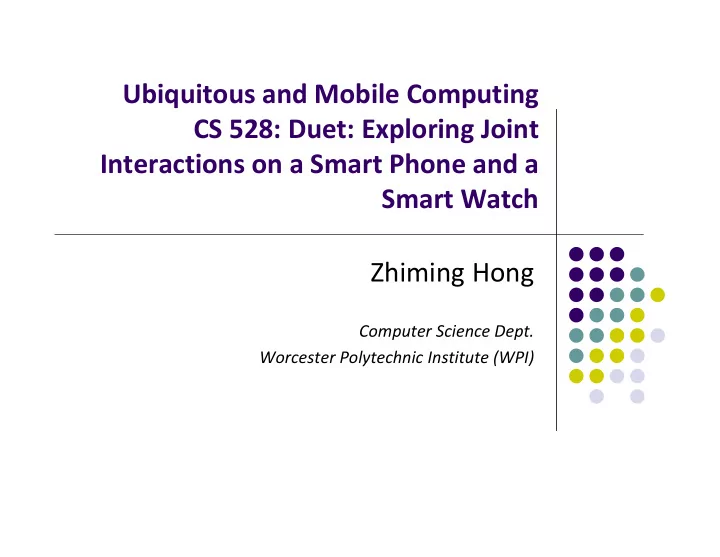

Ubiquitous and Mobile Computing CS 528: Duet: Exploring Joint Interactions on a Smart Phone and a Smart Watch Zhiming Hong Computer Science Dept. Worcester Polytechnic Institute (WPI)
Overview Introduction and motivation Related work Method Design space Gestures and sensing techniques Evaluation(Results) Duet system User feedback(Results) Conclusion Reference
Introduction
Introduction
Introduction + Multi-devices
Introduction New Interaction way Availability https://www.youtube.com/watch?v=oWu9TFJjHaM
Introduction What this paper focus on? Why this problem is important? https://www.youtube.com/watch?v=ZKGsb2F9dms
Related work Interaction Techniques for Handheld Devices Touch ‐ based interaction Orienting,positioning,tilting,and whacki ng Butler, A., Izadi, S., and Hodges, S. SideSight. UIST ’08 , 201–204 Jones, B., Sodhi, R., Forsyth, D., Bailey, B., and Maciocci, G. Around device interaction for multiscale Fitzmaurice, G.W. Situated information spaces and spatially aware palmtop computers. CACM 36 , 7 (1993), 39–49
Related work Interaction Techniques for Wrist ‐ worn Devices Zoomboard (iterative zooming) Motion and spatial awareness ( wrist ‐ based ) Free ‐ hand gestures (magnetometer) Oney, S., Harrison, C., Ogan, A., and Wiese, J.ZoomBoard. CHI ’13, 2799– 2803 Lyons, K., Nguyen, D., Ashbrook, D., and White, S. Face Rekimoto, J. GestureWrist and GesturePad. ISWC ’01, 21–27 Harrison, C. and Hudson, S.E. Abracadabra. UIST ’09 , 121–124
Related work Device ‐ to ‐ Device Interaction Synchrony Rekimoto, J. Pick ‐ and ‐ drop. UIST ’97 , 31–39 Proxemic Interaction Kortuem, G., Kray, C., and Gellersen, H. Sensing and visualizing spatial relations of mobile devices. UIST ’05 , 93 Distributed Interactions Schilit, B., Adams, N., and Want, R. Context ‐ Aware Computing Applications. First Workshop on Mobile Computing Systems an Applications , 85–90
Method Design space
Method GESTURES AND SENSING TECHNIQUES Watch in the Foreground, Phone in the Foreground Double bump Multi ‐ device gestures
Method GESTURES AND SENSING TECHNIQUES Watch in the Background, Phone in the Foreground Flip and tap Hold and flip Finger posture recognition Handedness recognition
Method Gesture Recognition machine learning Decision Tree
Method TECHNICAL EVALUATION Participants 12 participants( 5 male,7 female, ages 18 ‐ 34) each participant: 10 trials for each condition of these 6 gestures 12 participants × 15 conditions (across the 6 techniques) × 4 blocks × 10 trials per block = 7200 data points Ten ‐ Fold Cross Validation Per User Classifiers General Classifiers
Method TECHNICAL EVALUATION Results
Method DUET: AN EXPLORATION OF JOINT INTERACTIONS Home Screen 4 mobile apps Email Map Reader Call https://www.youtube.com/watch?v=i3XcCuWuec4
Method User feedback on DUET Participants 10 participants(5 male, 5 female, ages 21 ‐ 27) Procedure 60 minutes try out DUET by themselves comment on their easiness and usefulness
Method Results
Conclusion New interaction ways between smart phone and smart watch “Duet” system: exploring those new joint interactions Improvements: Number and variety of participants for test Recognition robustness Watch wearing
References [1] Inser Amento, B., Hill, W., and Terveen, L. The sound of one hand. CHI '02 , 724 ‐ 725. [2] Ballagas, R., Borchers, J., Rohs, M., and Sheridan, J.G. The Smart Phone. IEEE Pervasive Computing 5 , 1 (2006), 70–77. [3] Baudisch, P. and Chu, G. Back ‐ of ‐ device interaction allows creating very small touch devices. CHI ‘09 , 1923–1932. [4] Butler, A., Izadi, S., and Hodges, S. SideSight. UIST ’08 , 201–204. [5] Buxton, W. Integrating the periphery and context: A new taxonomy of telematics. GI ‘95 , 239–246 t references [6] Buxton, W.A.S. Chunking and phrasing and the design of human ‐ computer dialogues. IFIP ‘86 , 494–499. [7] Chen, G., and Kotz, D., A survey of context ‐ aware [8]mobile computing research . Technical Report TR2000 ‐ 381, Dept. of Computer Science, Dartmouth College, 2000. [9] Crossan, A., Williamson, J., Brewster, S., and Murray ‐ Smith, R. Wrist rotation for interaction in mobile contexts. MobileHCI ’08 , 435–438.
References [10] Hinckley, K., Pierce, J., Horvitz, E., and Sinclair, M. Foreground and background interaction with sensor ‐ enhanced mobile devices. TOCHI ’12, 1 (2005), 31–52. [11] Hinckley, K., Pierce, J., Sinclair, M., and Horvitz, E. Sensing techniques for mobile interaction. CHI ‘00, 91– 100. [12] Hinckley, K., Ramos, G., Guimbretiere, F., Baudisch, P., and Smith, M. Stitching. AVI ’04, 23–30. [13] Hinckley, K. Synchronous gestures for multiple persons and computers. UIST ’03, 149–158. [14] Holmquist, L.E., Mattern, F., Schiele, B., Alahuhta, P., Beigl, M., and Gellersen, H. Smart ‐ Its Friends. Ubicomp ‘01, 116–122. [15] Hudson, S.E., Harrison, C., Harrison, B.L., and LaMarca, A. Whack gestures. TEI ’10, 109–103. [16] Ishiguro, Y., Mujibiya, A., Miyaki, T., and Rekimoto, J. Aided eyes. AH ’10, 1–7. [17] Jones, B., Sodhi, R., Forsyth, D., Bailey, B., and Maciocci, G. Around device interaction for multiscale navigation. MobileHCI ’12, 83–92. [18] Kim, D., Hilliges, O., Izadi, S., et al. Digits. UIST ’12, 167–176. [19] Kim, J., He, J., Lyons, K., and Starner, T. The Gesture Watch. ISWC ’07, 1–8. [20] Kortuem, G., Kray, C., and Gellersen, H. Sensing and visualizing spatial relations of mobile devices. UIST ’05, 93.
Thank you! Question??
Recommend
More recommend